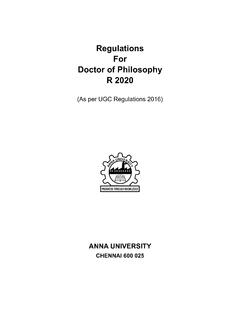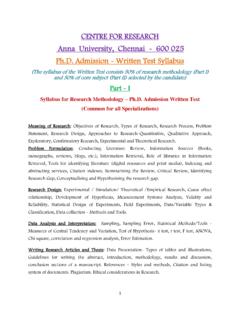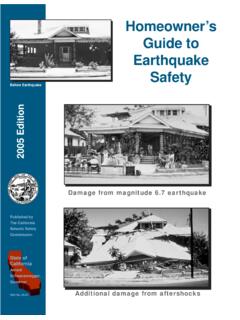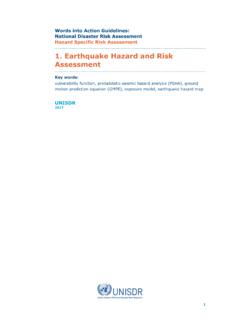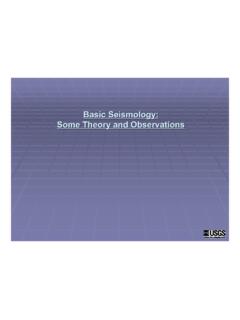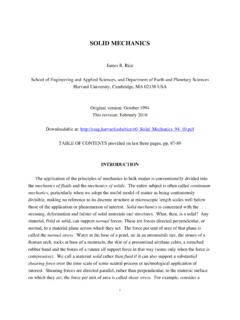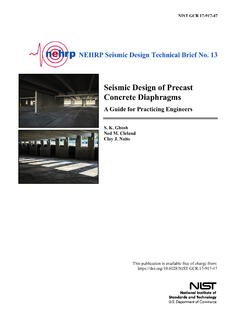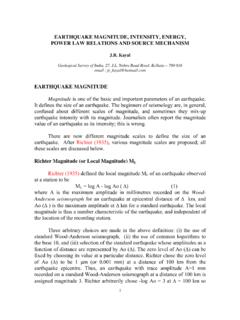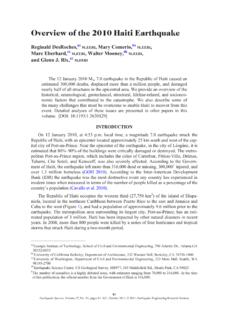Transcription of Syllabus for Ph.D. Admission - Written Test
1 Syllabus for Admission - Written Test Faculty of Civil engineering PCE1001 Transportation engineering UNIT - I Traffic engineering and Management Traffic Characteristics: Urban Road user characteristics- Vehicle and Traffic Stream Characteristics. Traffic Studies: Volume, speed, travel time and delay, O-D, Accident and parking studies LOS concept, factors affecting capacity and LOS, capacity of different types of facilities. Traffic Control and Management: Signs, markings, islands and signals; At-grade and grade separated Intersections; Rotaries; Basic principles of intersection signalization; Signal Regulation, Traffic Systems Management and Travel Demand Management - Congestion Management, Traffic Calming and Pricing-Design of Cycle Tracks, Pedestrian Facilities and parking design. Intersection Design and Analysis: Design of Intersection At grade intersection Uncontrolled, Channelisation, Rotary, Traffic Signal Control, Signal Co- ordination, Grade Separated Intersection - Types Design and Analysis.
2 Traffic Flow Fundamentals and Characteristics: Flow Parameters - Approaches to Traffic Flow - Spacing, Gap and Headway Characteristics Macroscopic and Microscopic Traffic Flow Models- Vehicular Stream Models- Queuing Theory-Delay at Intersections-Concepts and application of Intelligent Transportation Systems (ITS) -Traffic Enforcement. UNIE - II Urban and Transportation Planning Urban Planning : Classification of urban settlements, Urban infrastructure developmentZoning Regulation, Layout and Building and social concepts in urban and regional planning-Financing of Urban Developments projects and and Country planning act. Urban Transportation Planning Process:systems approach to planning process, problem definition, solution generation, solution analysis, evaluation and choice. Environmental and social Impat Assesment of Transport Projects. Transportation Systems Planning:Stages in Transportation Planning-TravelForecasting Process-Modal split models Mode choice behavior-Traffic assignment and methods-Land Use Transport Transport System- Bus Transit Planning And Scheduling-Rail Transit Terminals And Performance Evaluation- Policies and Strategies for Mass Transport.
3 Transport Economics: Principles of Economic 1. Analysis-Factors affecting vehicle operating cost-Transport demand and supply concepts-Public and Private Transport Financing and Pricing. Transportation Surveys: Transportation surveys definition of study area, zoning, home-interview survey, cordon-line and screen line surveys, traffic surveys, inventory of transport facilities, inventory of land-use and economic activities. UNIT - III Highway Design Highway alignment: Horizontal: Theoretical, general and design considerations; Super elevation; Simple, compound, reverse and transition curves; Guidelines for design; Vertical: Terrain; Grades; Climbing lanes; General considerations in vertical curves; Crest and sag vertical curves; Coordination of horizontal and vertical curves; Guidelines for design of hill roads. Design controls and criteria: Vehicle, driver and traffic characteristics and their influence on geometric design of highways; Access control -At grade intersection conflict points, channelization.
4 Cross section elements: Considerations with regard to cross section elements such as, carriageway width, right-of-way, camber, shoulders, kerbs, footpaths, drainage elements, traffic barriers and medians; Frontage roads- Pedestrian crossings- Bicycle facilities- Bus bays. Sight distances: Stopping, decision, overtaking and intermediate sight distances- Sight distances on horizontal curves and at intersections- Applications of sight distances for various situations UNIT - IV Pavement Materials, Design and Evaluation Pavement Materials and Construction: subgrade soils - aggregates- Bituminous binders and modified binders- Bituminous paving mixtures Mix Design, Material testing and evaluation- 3. Construction of gravel and stabilized bases-Cement concrete for highway construction- Types of pavements-Stresses in bituminous pavements and concrete pavements- Various design methods for Flexible and rigid pavements. Pavement Evaluation and Maintenance: Failures in pavements- evaluation and equipments-structural stability assessment of pavements- repair and maintenance-overlays-Pavement serviceability rating and index.
5 PCE1002 Computer methods and applications in Structural engineering /. Structural engineering UNIT - I Reinforced Cement Concrete Structures and Prestressed Concrete Structures 2. Concrete structures Design of reinforced concrete elements, flat slabs and yield line theory based design, design of water tanks, retaining walls, inelastic behavior of concrete structures, ductile detailing. Design of long and short span bridges, analysis and design of tall buildings, stability of tall buildings, wind effects on structures. Prestressed concrete -Design of flexural members-continuous and cantilever beams, design of tension and compression members, composite members ,losses of prestress, design of prestressed bridges, chimneys, poles, sleepers. UNIT - II Advanced Steel Structures Design of members subjected to combined forces - Design of connections - Riveted, Bolted and Welded - Analysis and design of industrial buildings - Sway and Non-sway frames - Plastic analysis of structures - Design of light gauge steel structures.
6 UNIT - III Dynamics and earthquake engineering Dynamics and earthquake engineering - Free and Forced Vibration of Single, Two and Multi Degree of Freedom Systems; Normal modes of vibration of Two Degree of Freedom Systems;. Orthogonality of modes; Mode superposition techniques; Dynamic response of Single, Two and Multi degree freedom systems, Mode superposition techniques, Dynamic response of continuous systems, Free and forced vibration of continuous systems, Rayleigh-Ritz method, Formulation using conservation of energy , virtual work, Direct integration methods for dynamic response;. Nonlinear MDOF systems, Numerical Integration Algorithms, Substructure technique. earthquake Ground motion, engineering seismology , Characteristics of earthquakes, Estimation of earthquake parameters - Effects of earthquake on structures, Response spectra, Evaluation of earthquake forces, earthquake resistant design of masonry and RC structures, Capacity based design and detailing, Structural systems, Shear walls, Rigid Frames, Principles and guidelines for earthquake resistant design, Design guidelines for earthquake resistant masonry buildings, Vibration control techniques, Tuned Mass Dampers, Seismic base isolation.
7 UNIT - IV Concrete Technology and Repair and Rehabilitation Of Structures Concrete making materials - Mix Design - Special Concretes - High strength Concrete - High Performance Concrete - High density Concrete - Fibre Reinforced Concrete - Geopolymer Concrete - Bacterial Concrete - Nano Concrete - Ready mixed Concrete - Self compacting Concrete - Concrete made out of Industrial Wastes - Fresh and hardened concrete properties- Concreting Techniques - Life cycle behaviour of Structures - Different forms of cracks - factors 3. responsible for deterioration of concrete - Defects in steel ,masonry and concrete structures - causes - effects-Damage assessment - strength and durability parameters - NDT - Repair Techniques-Strengthening of structural elements - Engineered Demolition. UNIT - V Structural Analysis and Finite Element Analysis Axial deformation of bars, Analysis of framed structures, Plates and shells, Applications of finite element for elastic stability, Dynamic analysis.
8 PCE1003 Advanced Construction Technology / Construction engineering and Management / Infrastructure engineering UNIT - I Construction Planning, Scheduling and Control Defining Work Tasks - Estimating Activity Durations - Construction Schedules - Critical Path Method Scheduling Calculations- Use of Advanced Scheduling Techniques- Crashing and Time/Cost Tradeoffs- The Project Budget- Schedule and Budget Updates- Relating Cost and Schedule Information- Total Quality Control - Quality Control by Statistical Methods- Safety- Types of Project Information-- Computerized Organization and Use of Information. UNIT - II Project Formulation and Appraisal and Contract Laws and Regulations Project Formulation, Project Costing, Project Appraisal, Project Financing, Private Sector Participation- Contract Laws and Regulations - Construction contracts, Indian contract act, Torts, Contractual problems, Tamilnadu transparency in tenders act, E-tenders, Arbitration, Legal requirements, Insurance and bonding, Labour acts.
9 UNIT - III Resource Management and Control and Quantitative Techniques In Management Resource planning, Labour management, Materials and equipment, Time management, Resource allocation and leveling .Operations research, Production management, Working capital Management, Decision theory, Managerial economics. UNIT - IV Concrete Technology and Repair and Rehabilitation of Structures Concrete making materials - Mix Design - Special Concretes - High strength Concrete - High Performance Concrete - High density Concrete - Fibre Reinforced Concrete - Geopolymer 4. Concrete - Bacterial Concrete - Nano Concrete - Ready mixed Concrete - Self compacting Concrete - Concrete made out of Industrial Wastes - Fresh and hardened concrete properties- Concreting Techniques - Life cycle behaviour of Structures - Different forms of cracks - factors responsible for deterioration of concrete - Defects in steel ,masonry and concrete structures - causes - effects-Damage assessment - strength and durability parameters - NDT - Repair Techniques-Strengthening of structural elements - Engineered Demolition.
10 UNIT - V Construction Techniques and Equipment Equipment for earthwork, asphalt and concrete plants and materials handling - Equipment for dredging, trenching, tunneling, drilling, blasting, pile driving, demolition, dewatering and grouting - Cranes- Modern equipment- Construction Equipment Management - Construction techniques for sub structure construction - Super structure construction techniques for buildings including tall buildings, prestressing and post tensioning Construction techniques for the construction of special structures like towers, silos, chimneys, TLT, skyscrapers, bridges, domes, jetties, breakwater structures, support structure for heavy machinery, articulated structures and space decks Demolition Techniques. PCE1004 Geotechnical engineering / Soil Mechanics and Foundation engineering UNIT - I Soil Properties and Strength Behaviour Different soil deposits classification and identification clay minerals diffused double layer swelling and shrinkage behavior liquefaction potential factors affecting compressibility, permeability, shear strength - conduction phenomena-Factors affecting stress- strain characteristics triaxial testing and stress path pore pressure parameters failure theories constitutive law for soil limitations of model critical state line dilation effect.
